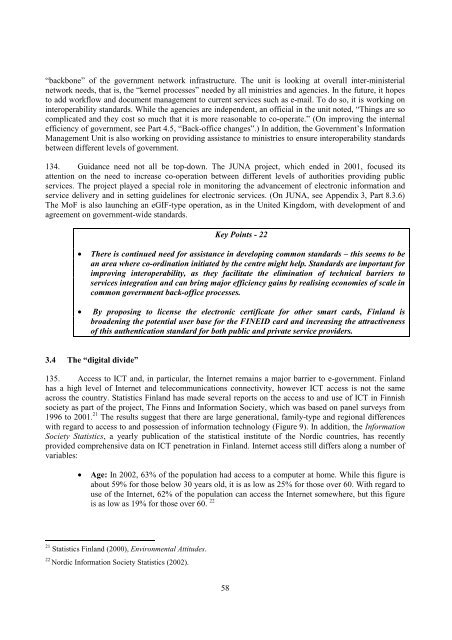e-GOVERNMENT IN FINLAND - ePractice.eu
e-GOVERNMENT IN FINLAND - ePractice.eu
e-GOVERNMENT IN FINLAND - ePractice.eu
Create successful ePaper yourself
Turn your PDF publications into a flip-book with our unique Google optimized e-Paper software.
“backbone” of the government network infrastructure. The unit is looking at overall inter-ministerial<br />
network needs, that is, the “kernel processes” needed by all ministries and agencies. In the future, it hopes<br />
to add workflow and document management to current services such as e-mail. To do so, it is working on<br />
interoperability standards. While the agencies are independent, an official in the unit noted, “Things are so<br />
complicated and they cost so much that it is more reasonable to co-operate.” (On improving the internal<br />
efficiency of government, see Part 4.5, “Back-office changes”.) In addition, the Government’s Information<br />
Management Unit is also working on providing assistance to ministries to ensure interoperability standards<br />
between different levels of government.<br />
134. Guidance need not all be top-down. The JUNA project, which ended in 2001, focused its<br />
attention on the need to increase co-operation between different levels of authorities providing public<br />
services. The project played a special role in monitoring the advancement of electronic information and<br />
service delivery and in setting guidelines for electronic services. (On JUNA, see Appendix 3, Part 8.3.6)<br />
The MoF is also launching an eGIF-type operation, as in the United Kingdom, with development of and<br />
agreement on government-wide standards.<br />
Key Points - 22<br />
x There is continued need for assistance in developing common standards – this seems to be<br />
an area where co-ordination initiated by the centre might help. Standards are important for<br />
improving interoperability, as they facilitate the elimination of technical barriers to<br />
services integration and can bring major efficiency gains by realising economies of scale in<br />
common government back-office processes.<br />
x By proposing to license the electronic certificate for other smart cards, Finland is<br />
broadening the potential user base for the F<strong>IN</strong>EID card and increasing the attractiveness<br />
of this authentication standard for both public and private service providers.<br />
3.4 The “digital divide”<br />
135. Access to ICT and, in particular, the Internet remains a major barrier to e-government. Finland<br />
has a high level of Internet and telecommunications connectivity, however ICT access is not the same<br />
across the country. Statistics Finland has made several reports on the access to and use of ICT in Finnish<br />
society as part of the project, The Finns and Information Society, which was based on panel surveys from<br />
1996 to 2001. 21 The results suggest that there are large generational, family-type and regional differences<br />
with regard to access to and possession of information technology (Figure 9). In addition, the Information<br />
Society Statistics, a yearly publication of the statistical institute of the Nordic countries, has recently<br />
provided comprehensive data on ICT penetration in Finland. Internet access still differs along a number of<br />
variables:<br />
x Age: In 2002, 63% of the population had access to a computer at home. While this figure is<br />
about 59% for those below 30 years old, it is as low as 25% for those over 60. With regard to<br />
use of the Internet, 62% of the population can access the Internet somewhere, but this figure<br />
is as low as 19% for those over 60. 22<br />
21 Statistics Finland (2000), Environmental Attitudes.<br />
22 Nordic Information Society Statistics (2002).<br />
58
















